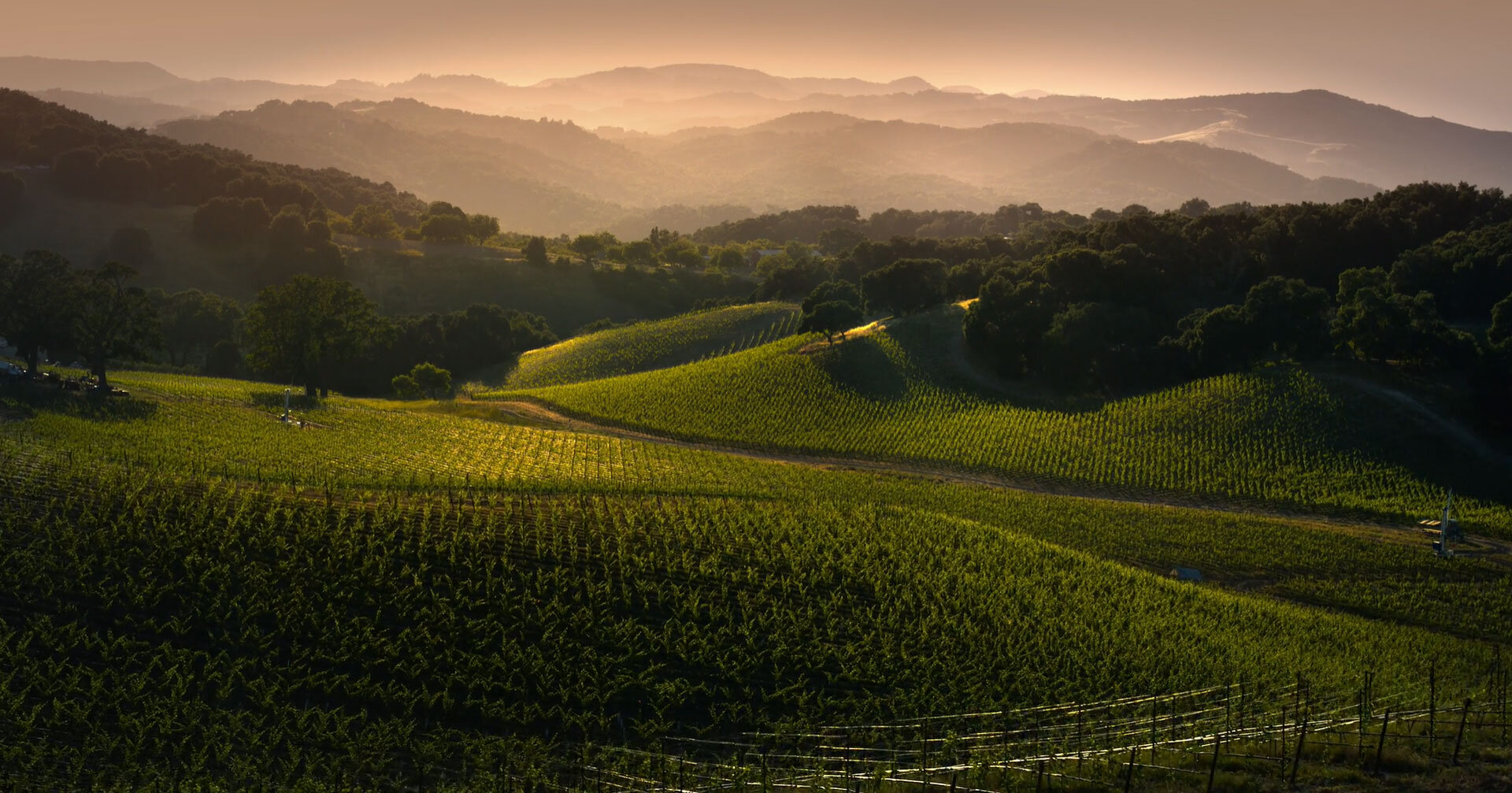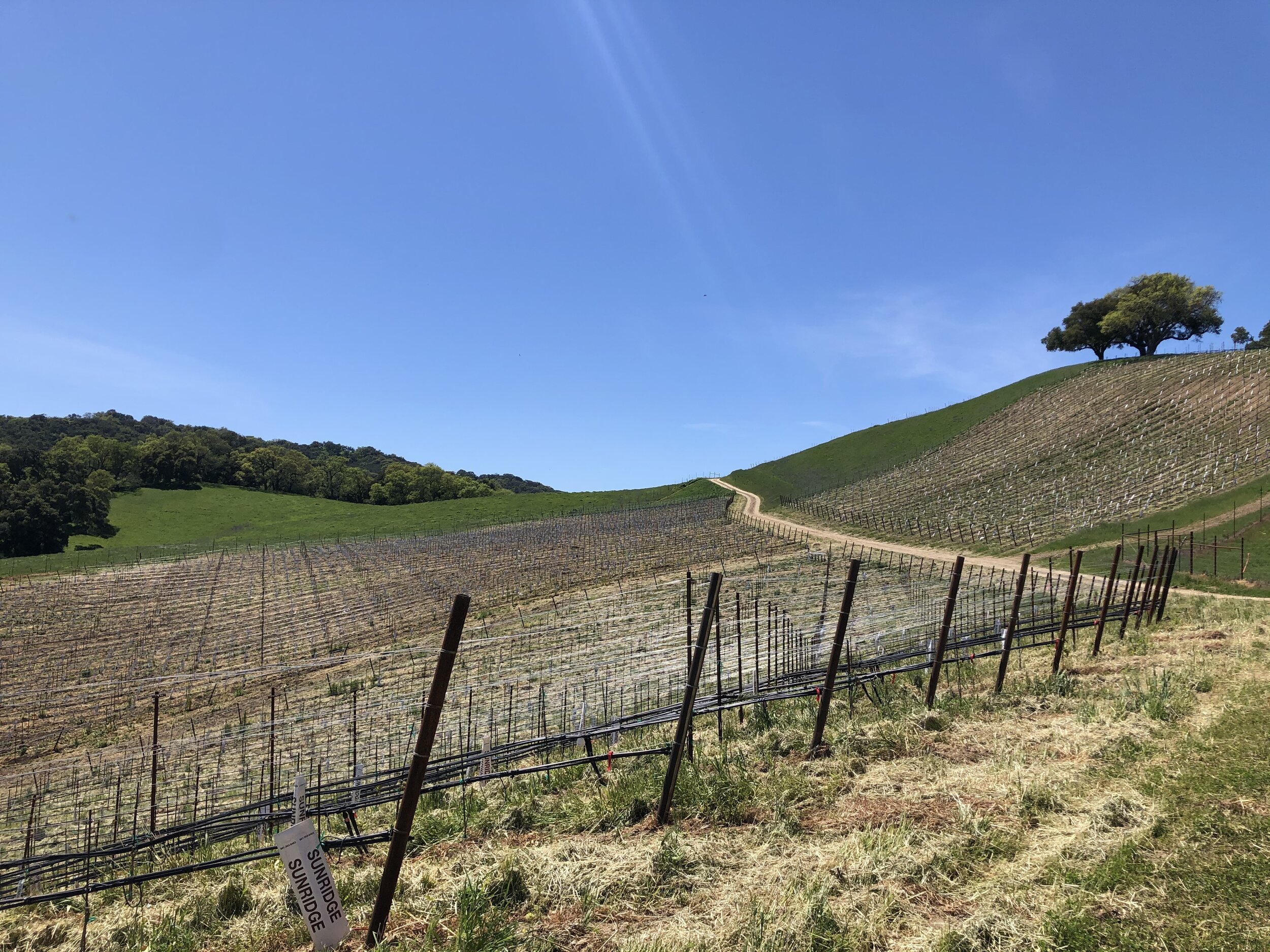
CASE STUDY
MoonSprings Vineyard
Bridging The (Templeton) Gap
We were contacted by Lynn and O’Neal Gray pretty much out of the blue back in 2016. Recommended by their real estate agent, they got in touch to see if we could help with the transformation of their newly-acquired property just outside Paso Robles. It turned out to be a dream project for us. The Texan family had just relocated from Dallas to a beautifully sprawling 515-acre estate. Their ambitious plan was to convert around a third of the property into an ultra premium vineyard, while restoring the natural beauty of the land around it. We couldn't have been happier to help.
MoonSprings is an extraordinary place. A fairly untouched 120-year-old hay and cattle ranch in the Templeton Gap District, the property benefits from many natural features that make it ideal for growing high quality grapes. Lying in the foothills of the Santa Lucia mountains, MoonSprings has elevations from 960 to over 1,600 feet above sea level. These hillsides provide the air circulation and temperature regulation vines need to thrive. And with the Pacific Ocean only a few miles away, cool nightly breezes supply diurnal temperature fluctuations of around 50 degrees. These all give fine conditions for growing and ripening healthy, ultra premium grapes.
Going Underground
We worked closely with the Grays to bring their vision of a fully sustainable 175-acre vineyard to life. As well as ensuring the vineyard balanced with the rest of the estate, they wanted it to fully express the quality of the Templeton Gap terroir. We began by analyzing the proposed site to identify its feature and attributes. After a survey of the soils, subsoils and bedrocks, we looked at water. Using specialist subterranean mapping equipment we identified an aquifer beneath the estate and dug a series of wells around it. Finding some potentially problematic deposits in the groundwater, we installed a reverse osmosis filter to keep the three affected wells refreshed. We then brought in seven 10,000-gallon tanks for water storage, which not only allow the wells to be rested but eliminates the evaporation problems associated with open reservoirs.
One of the pleasure of working on the MoonSprings project has been the Gray's commitment to building a quality-focused and sustainable vineyard, while taking a long-term view of its impact on the surrounding land. We were able to utilize a full suite of best practices to ensure MoonSprings would grow in harmony with the natural ecology of the estate around it for many years to come. While we meticulously designed and built the vineyard to produce exceptional quality grapes, we also made sure it would be prepared for whatever environmental challenges the future holds. Naturally, water is a key part of ensuring the vineyard's success.
River Deep, Mountain High
Throughout the preparation and planting of the MoonSprings vineyard, improving it water resources was paramount. Although we planned for the vines to be substantially dry-farmed within four years of planting, we did all we could to ensure the site is water sufficient for the future. The health of MoonSpring's aquifer was a vital part of this, and with the Grays committed to protecting the property's numerous creeks, springs and blue line streams, we were able to improve its replenishment by diverting much of the vineyard valley's runoff back into it. We used the rocks we retrieved while cultivating the vineyard to slow down and shore up the site's natural waterways. We then used the smaller rocks to create natural purification and silting dams in the drainage areas of the vineyard. This all helped to improve the property's water conservation and erosion, while diverting much of the runoff flow back to the aquifer.
Despite improving the aquifer and installing an additional 60,000 gallons of water storage, the plan was always to minimize MoonSpring's water use. This isn't just about conservation: we believe that carefully controlled irrigation is essential for creating healthy, resilient, and deep-rooting vines. We used the latest hi-tech water monitoring technologies in the vineyard to ensure irrigation is only used if, as, and when needed during the vines' establishment. Our irrigation specialist developed a state-of-the-art system that delivers water literally plant-by-plant. We put in double drip lines through the entire vineyard with emitters on each vine. For hillside blocks, we split the lines further, adding separate valves at the top and bottom. The lines are all connected to an automated system that is monitored both on the property and remotely. It features soil moisture probes and other underground monitoring devices that determine exactly how much water each vine requires. With flow meters on every well, we ensure that only the right amount of water is delivered to each plant, according to its need.
The Regenerative Approach
MoonSprings is more than just a well designed, premium grape-producing vineyard. It became a rare chance to demonstrate how a large piece of land can be managed using regenerative farming principles to balance and benefits the natural world around it. Such was the Gray family's passion for the highest environmental standards, we were able to develop an uncompromising philosophy for MoonSprings vineyard. Put simply: each grape will always be given the time it needs to reach its full potential and never be rushed for the sake of production. This artisan viticulture approach is based on the overarching – but often overlooked – principle that the demand for quality grapes can only be answered as natural resources warrant. In other words, MoonSprings' grapes are produced in harmony with nature, not in a struggle against it.
To do this properly, we developed the vineyard along a phased approach, allowing us a full attention to detail at every stage. For planting, we followed a strict 6ó’ x 4’ spacing for every acre. As the vines went in, we used steel-ended posts, a metal stake every few vines, elevated double drip lines, cordon wire and a VSP trellis system (unless the vines were to be head trained). Where possible, the vineyard rows were planted 38 degrees off true north to ensure every grape grows in the shelter of natural leaf cover, exposed only to filtered sunlight. While this tighter spacing works out around four times more expensive than less dense vineyards and results in fewer grapes per plant, the fruit that is produced is of significantly higher quality.
A Path Through The Forest
To make sure the vineyard grows in harmony with the entire wildlife estate, we designed it around MoonSprings' existing oak woods. These mature trees are vital in maintaining the natural balance and biodiversity of the property, and we wanted the vines to benefit from them. The Grays brought in a certified arborist whom we worked with so that no trees were felled or damaged during construction and planting of the vines. Keeping these woodlands wild and thriving – while maintaining a healthy ratio of vines-to-natural habitat – ensures that MoonSprings continues to be a vital habitat for the deer, hawks, eagles, condors, bobcats, snakes and bear that live among its woodlands. What's more, right from the outset we made sure a wildlife corridor would continue to span the entire 515-acre property. With deer fencing limited only to vineyard areas, wildlife migration patterns remain minimally affected.
So, with the water reserves readied, the vines planted and the trellis and irrigation systems installed, we have been able to utilize our full spectrum of regenerative farming practices to establish and manage MoonSprings. By taking an holistic approach to tending the vines in harmony with the natural world around them, we're letting the vineyard becomes part of the estate. The beauty of MoonSprings is that the 175-acre vineyard is balanced with the rest of the property. Its antiquity orchards, olive groves, walnut trees, cover crops, blue line plantings, mature oaks, goats, dogs, cats, sheep, cattle, bees, owls, bats and snakes all work in synergy with the vines. By focusing attention on the vineyard's overall biodiversity, while improving its water cycle and managing the brush, we're creating healthier soils, a richer, more biodiverse environment and, ultimately, better grapes.
Owls, Bats, Birds & Bees
Non-chemical methods of pest control are used extensively throughout MoonSprings. We installed over sixty-five owl boxes in the trees around the vineyards to establish a population of awesome nightime vine guards. Owls are one of the best methods of rodent control we know. Similarly, we're enhancing habitats that encourage bats and small birds, both of which are great allies in naturally controlling vine-damaging insects, day and night. Vineyard chickens also play an important role by eating vine pests and providing fertilizer through the vineyard as they roam. These natural solutions are not only highly effective for the long term, they're also self-managing methods that save time, expense and pollution over chemical and other invasive techniques.
Alongside natural pest control, we've established a diverse system of cover crop management to protect and enrich the vineyard's topsoils. MoonSprings' comprehensive erosion control and water protection plan was developed by a team of engineers and approved by the Natural Resources Conservation Service and the Resource Conservation District. It features a wide range of cover crop applications, composed of erosion-preventing seed mixes, bio-disposable straw waddles, straw netting, blown straw and silt fences. Through the seasons we also apply natural soil additives such as compost, compost tea and fish emulsions via the vineyard drip lines, which boosts plant health and encourages microbial diversity in the soils. Flowering crops are planted too, which attract beneficial insects to the vines and help make the vineyards blend into the surrounding countryside. In some parts of the vineyard, where necessary, we also use clove oil to control weeds.
The Whole Farm Vineyard
Managing the underbrush has been another important (if unexciting) aspect in establishing MoonSprings vineyard. The Grays' ever-hungry goat herd – tended by their canine caretakers Templeton and York – happily graze the property's blue line and woodland areas, providing efficient and environmentally friendly brush control. By doing this work we are protecting MoonSprings from fires, which increases its resilience to climate change and strengthens the ecosystem. Cattle also assist in keeping combustible vegetation to a minimum during the summer months, when the danger of fire is greatest. In the winter, when the vines are dormant, 350 sheep and lambs roam the vines to naturally mow the cover crops, while also working their nutritionally-rich natural fertilizer back into the soil.
All in all, MoonSprings vineyard is looking good. The planting of the vines was carried out in 2018 and they are establishing well. With our 'just-enough' watering approach, the plants are growing slowly, but with strong root systems. 2019 and 2020 were both challenging years, but MoonSprings is flourishing. Many of the measures we put in place to retain water, encourage wildlife and promote natural biodiversity are paying off. Cover crops and natural harvesting have lead to rich, microbially active topsoils that trapping water in the subsoils. This period of vine-establishment is of course always a little frustrating as we must wait to enjoy the fruits of our labor, but the work we are doing to integrate the vineyard into the MoonSprings terroir feels significant.
We knew from the outset that MoonSprings could be a beacon for what a regeneratively-farmed vineyard can achieve. If great wines are made in the vines – and at RVS we firmly believe they are – then establishing the vineyard as part of the surrounding land, and treating that land with the respect it deserves, will produce grapes of exceptional quality. For not we're simultaneously holding our nerve on certain decisions, while refining others to help strengthen the vineyard as it develops. As always with nature, it's a waiting game, but one made all the more pleasant by the beauty and scale of the surroundings. What we do is not really about today or tomorrow – it's about the future. And its the future that will judge our actions. As stewards of the land, we want our impact to be positive and beneficial, both for our clients, their children, and mother nature.







